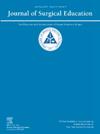比较同行与近同行反馈在家庭腹腔镜课程
IF 2.1
3区 医学
Q1 EDUCATION, SCIENTIFIC DISCIPLINES
引用次数: 0
摘要
目的腹腔镜手术的专职教师数量有限。以前我们观察到,学习者给他们的同伴提供有效的异步反馈,与教师一样。我们假设老年住院医师近同伴可以通过展示先进的技术知识来提供优于同伴的反馈,同时分享同伴反馈中看到的教育效益。初级外科住院医师完成了9个阶段的腹腔镜任务课程,并将视频上传到在线平台。在实验设计中,居民随机接受同伴(同一水平)或近同伴(PGY4)的视频评价。以任务特定标题评估的绩效和面对面最终评估的完成时间采用t检验进行比较。对参与者的半结构化访谈进行定性分析,比较同伴和近同伴的反馈。在两个城市设立一个单一的学术机构,提供住院医师项目。51名来自3个专科(普外科、妇产科、泌尿外科)的PGY1-2住院医师。结果在同行(N = 10)和近同行(N = 7)队列中,评估期间的平均(SD)总积分(56[5.5]和60 [4.3],p = 0.160)或总(SD)时间(1029[289]和887[278]秒,p = 0.355)的最终评估表现相似。对来自同伴组的3名参与者和来自近同伴组的5名参与者的采访确定了3个主要主题。首先,不同的问责机制与评估者的角色有关,注意到参与者在他们的高级住院医师近同龄人面前保持声誉的动机;相比之下,与同伴一起工作感觉更具有协作性和支持性。其次,参与者指出,他们在给予和接受反馈的过程中学习,评估同伴提供了一种社区意识。第三,课程的价值很大程度上在于课程设计,包括视频示例或规则,这些示例或规则使反馈标准化,而不考虑评估者的专业知识。结论同伴反馈组的社会学习能力和学习环境较近同伴组强。此外,在反馈质量方面没有特别的优势。本文章由计算机程序翻译,如有差异,请以英文原文为准。
Comparing Peer vs. Near Peer Feedback in an At-Home Laparoscopic Curriculum
OBJECTIVE
Skilled faculty instructors for laparoscopy are limited. Previously we observed that learners give effective asynchronous feedback to their peers, on par with faculty. We hypothesize that senior resident near-peers can give superior feedback compared with peers by exhibiting advanced technical knowledge, while sharing educational benefits seen in peer feedback.
DESIGN
Junior surgical residents completed a 9-stage curriculum of laparoscopic tasks, with videos uploaded to an online platform. In experimental design, residents were randomized for video review by peers (same level) or near-peers (PGY4). Performance assessed with a task-specific rubric and completion time on an in-person final assessment was compared with t-test. Qualitative analysis of semi-structured interviews with participants compared peer and near-peer feedback.
SETTING
A single academic institution with residency programs in 2 cities.
PARTICIPANTS
Fifty-one invited PGY1-2 residents from 3 specialties (general surgery, OB-GYN, urology).
RESULTS
Final assessment performance was similar among peer (N = 10) and near-peer (N = 7) cohorts as seen in mean (SD) total points (56 [5.5] and 60 [4.3], p = 0.160) or total (SD) time taken (1029 [289] and 887 [278] seconds, p = 0.355) during the assessment. Interviews with 3 participants from the peer group and 5 from near-peer identified 3 major themes. First, different accountability mechanisms relate to assessor role, noting that participants were motivated to maintain reputation in front of their senior resident near-peers; in contrast, working with peers felt more collaborative and supportive. Second, participants noted they learn as they gave and received feedback, and evaluating one’s peers provided a sense of community. Third, the value of the curriculum is largely in the curriculum design, including video examples or rubrics which standardize feedback regardless of assessor expertise.
CONCLUSIONS
Social learning and the learning environment appeared stronger in the peer feedback group relative to the near-peer group. Additionally, no particular advantage was noted in feedback quality given by near-peers.
求助全文
通过发布文献求助,成功后即可免费获取论文全文。
去求助
来源期刊

Journal of Surgical Education
EDUCATION, SCIENTIFIC DISCIPLINES-SURGERY
CiteScore
5.60
自引率
10.30%
发文量
261
审稿时长
48 days
期刊介绍:
The Journal of Surgical Education (JSE) is dedicated to advancing the field of surgical education through original research. The journal publishes research articles in all surgical disciplines on topics relative to the education of surgical students, residents, and fellows, as well as practicing surgeons. Our readers look to JSE for timely, innovative research findings from the international surgical education community. As the official journal of the Association of Program Directors in Surgery (APDS), JSE publishes the proceedings of the annual APDS meeting held during Surgery Education Week.
 求助内容:
求助内容: 应助结果提醒方式:
应助结果提醒方式:


